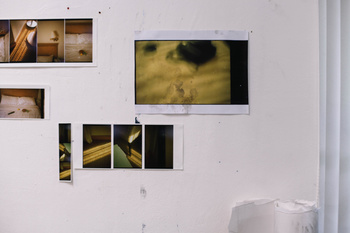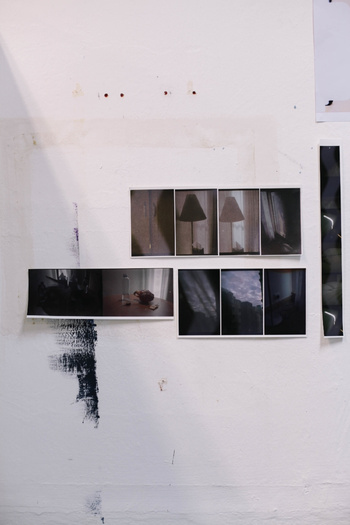A collection of conversations with a diverse range of local and regional creatives
Library Conversations for SGABF2020
We examined the systems that support art book making and independent art book publishing in Singapore and the region.
A Closer Look for SGABF2019
We gathered perspectives on our zine and art book culture, and discuss the possibilities of self-publishing today.
21 Creatives for SGABF2018
We sat down with 21 creatives of various disciplines to learn about their practice and asked each of them to fill up a blank page in a notebook.
SGABF: Your works deal with the quirks of the human experience. In examining sex as a visual language, why did you choose to specifically draw from what society deems as discomforting?
Liana Yang (LY): I won’t say it’s always about sex but rather sex is used as a reference or starting point. The sexual references often seen in some of my works functions more as a subversion in which I question the human condition. Moreover, intimacy and passion are linked to love and desire too.
My main interest is really about relationships. I am extremely fascinated with human interactions and emotions. More specifically, human interactions and the ambiguity and duality of it. For the past 4 years, I have been exploring what modern romance and love are about by trying out online dating. I am also very fascinated with the triviality in life - the mundane things we take for granted. The references to sex might seem trivial, but at the same time sex is also a compelling way to draw the audience in.
Essentially, what I am exploring is much deeper and there are many more layers to it. Sex is just one of the many facets, because it is a mix of passion, desire, and love. If you examine these individually, they are all unique.
But when you lump them all together, the end product is usually sexual, so to speak. There is something very animalistic about it but it’s that complication and tension that I find interesting and worth exploring. These days, modern romance and relationships have become a minefield, like how it could mean one thing but also another. There is something very transactional about sex and how we handle relationships these days too. Coupled with what we see on social media which is constantly shaping and trying to project an ideal lifestyle in a certain fantastical way. But what is an ideal relationship or ideal happiness? It leads us to crave for certain things that might not be that important or useful.
From the experiences and the people that I meet through online dating, I gather information and try to see how I can create new work. Sometimes, friends would jokingly ask if the guy that I am dating is going to be my next “new project”. However, it is important that the ‘man’ or the 'subject matter' in my work is always anonymous. This is crucial as I want the audience to inject their own narrative and experiences into my artwork.

LY: It has to convey a certain feeling and ambiguity. That is why I like working with photography. A photograph doesn’t disclose the full truth even though it’s an equipment of documentation. Image-making to me has to work around what I am exploring. There is a certain fleeting and lo-fi quality to my work because it is also voyeuristic in nature. As each narrative or work is my invitation to the viewer to indulge in their own personal experiences.
From the experiences and the people that I meet through online dating, I gather information and try to see how I can create new work. Sometimes, friends would jokingly ask if the guy that I am dating is going to be my next “new project”. However, it is important that the ‘man’ or the 'subject matter' in my work is always anonymous. This is crucial as I want the audience to inject their own narrative and experiences into my artwork.

Photo Credit: SGABF
SGABF: What’s most important in image making to you?
LY: It has to convey a certain feeling and ambiguity. That is why I like working with photography. A photograph doesn’t disclose the full truth even though it’s an equipment of documentation. Image-making to me has to work around what I am exploring. There is a certain fleeting and lo-fi quality to my work because it is also voyeuristic in nature. As each narrative or work is my invitation to the viewer to indulge in their own personal experiences.

Photo Credit: SGABF
SGABF: Have you ever had to deal with your works being deemed as too ‘provocative’ in your career? From your experience, is that more of a setback or distinctive trait that does more good for artists like yourself?
LY: Perhaps yes and no. As mentioned, I weave a mix of truth and fiction into my artworks. Take for example, one can never tell where the exact location is - if it's my bedroom, someone else's, or a hotel room, and who the person is exactly. Nobody really knows for sure if it is staged, or did happen or not.
SGABF: When faced with an installation, the viewer connects with the artist through his or her work. When putting your works up at such shows, how do you mediate this form of connection or conversation with the viewer for yourself?
LY: I try to create an experience instead of showing static images. How I incorporate my work and use the site for my work are very important. When viewers go into my show, it is the experience that I want them to take away. Apart from just images, it can be a combination of sound, videos and even scent. The human senses are not just limited to vision, it’s a combination of everything. Hence, I try to show works so that allows the viewers to experience something a bit more.
SGABF: Beyond installations and gallery shows, do you think there’s room for platforms like Singapore Art Book Fair to bridge tangible connections between viewers and visual artists like yourself?
LY: Definitely! The art book itself is a very critical piece of art object because it brings longevity after the show.
I’ve always believed in that, which is why I create books and zines myself too. It’s something you can hold and cherish. In a book form, the viewer also get to experience the work in a different angle which is curated and edited by the artist. So yes, the art book is very important, it acts as a portable vessel or vehicle to show a body of work in a different way.

LY: I hope for it to be more critically engaging, in terms of approach and understanding, as well as having more interesting spaces available to work in and to showcase work. There is definitely increased support for the arts, but there is still a lot to be done with education. I am not trying to say that there should be more provocative works but rather, increased education on how the public could approach other types of artworks because education seems to be focused on more family and community oriented works. The provision of more unique spaces is essential to challenge how artists can produce and showcase works that are out of the usual whitewashed walls, as well as catering for a different meaningful audience engagement.
Liana Yang is rarely motivated by direct beauty, but rather by the aesthetics of social and sociological interactions. She is drawn to the trivialities and oddities that we encounter in our daily experiences. This includes the enigmatic and unseen aspects of relationships, as well as explorations of memory and associations in our contemporary culture.

Photo Credit: SGABF
SGABF: Where do you hope Singapore will be in terms of our arts and culture in the next 10 years?
LY: I hope for it to be more critically engaging, in terms of approach and understanding, as well as having more interesting spaces available to work in and to showcase work. There is definitely increased support for the arts, but there is still a lot to be done with education. I am not trying to say that there should be more provocative works but rather, increased education on how the public could approach other types of artworks because education seems to be focused on more family and community oriented works. The provision of more unique spaces is essential to challenge how artists can produce and showcase works that are out of the usual whitewashed walls, as well as catering for a different meaningful audience engagement.
Liana Yang is rarely motivated by direct beauty, but rather by the aesthetics of social and sociological interactions. She is drawn to the trivialities and oddities that we encounter in our daily experiences. This includes the enigmatic and unseen aspects of relationships, as well as explorations of memory and associations in our contemporary culture.
© Singapore Art Book Fair 2025. All rights reserved.
For further enquiries, please contact us at info@singaporeartbookfair.org.
Singapore Art Book Fair is organised by

For further enquiries, please contact us at info@singaporeartbookfair.org.
Singapore Art Book Fair is organised by

